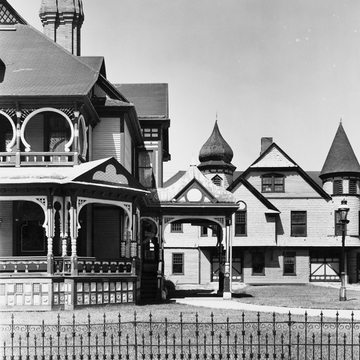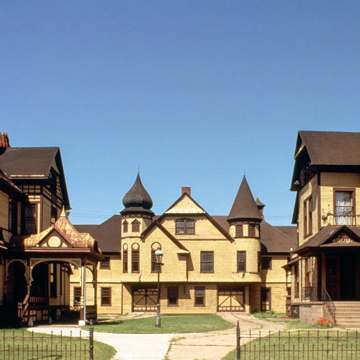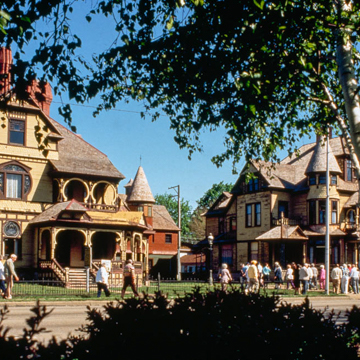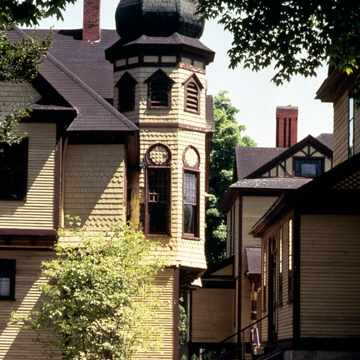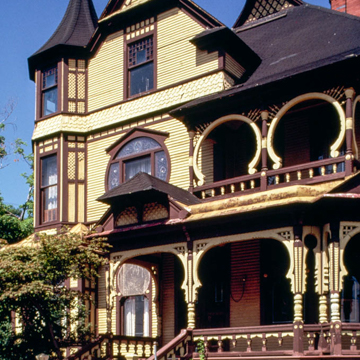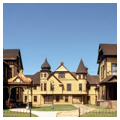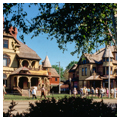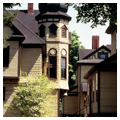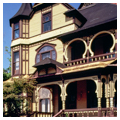You are here
Hackley and Hume Historic Site (Charles H. and Julia E. Moore Hackley House, and Thomas and Margaret Ann Banks Hume House)
The sumptuous Queen Anne house of lumberman Charles H. Hackley is unexcelled in Michigan. Its irregular silhouette is composed of assorted gables, clustered chimneys, bays and porches, and an octagonal corner tower. The rich textures and colors of latticework and shingles and the skillfully carved, turned, and molded spindles, posts, and horseshoe openings enliven the surface of the pine-clapboarded wood-frame house, raising it to the very heights of picturesque. The interior is even more lavishly ornamented with cherry, oak, and butternut woodwork, fireplaces, stained glass, fabric wall covers, ceramic tile, and metals. The Kelly Brothers Manufacturing Company, highly skilled Muskegon woodworkers, did the exquisite interior carving. The reception hall gives the first and most opulent impression of the grandeur of the house.
Hackley came to Muskegon in 1857, reportedly without money. When he died in 1905 his estate was worth more than $12 million. During his life and through his will he gave over $6 million to the city. This home is eloquent testimony to both his personal flamboyance and his success. It was located just up the hill and three blocks away from the Hackley and Hume offices on Western Avenue and 8th Street. The Lakeshore Museum Center, formerly the Muskegon County Museum, owner of the Hackley and Hume houses since 1986, meticulously restored the Hackley house with funds from a millage.
The Hackley house was designed by architect Hopkins (1834–1918), of Argyle, New York, who came to Grand Rapids in 1864 and who originated a mail-order system of selling house plans. He also designed the Thomas and Margaret Ann Banks Hume House, which was built at the same time and by the same carpenters and workmen. It is a larger Queen Anne residence with a profusion of porches, bays, tower, and gables to accommodate the Hume family of seven children. But it is also less ostentatious than the Hackley house and is a gentle, but clear reminder that Hackley, who owned three-fourths of Hackley and Hume, was the senior partner of the firm. The carriage house behind and between the two houses was held in common, each half reflecting the style of its respective home. Hume (1848–1937) arrived in Muskegon in 1872 and worked his way up to the position of bookkeeper for Hackley and McGordon. Later Hackley made Hume a partner, and Hume carried on many of the day-to-day details of running Hackley and Hume.
Writing Credits
If SAH Archipedia has been useful to you, please consider supporting it.
SAH Archipedia tells the story of the United States through its buildings, landscapes, and cities. This freely available resource empowers the public with authoritative knowledge that deepens their understanding and appreciation of the built environment. But the Society of Architectural Historians, which created SAH Archipedia with University of Virginia Press, needs your support to maintain the high-caliber research, writing, photography, cartography, editing, design, and programming that make SAH Archipedia a trusted online resource available to all who value the history of place, heritage tourism, and learning.






